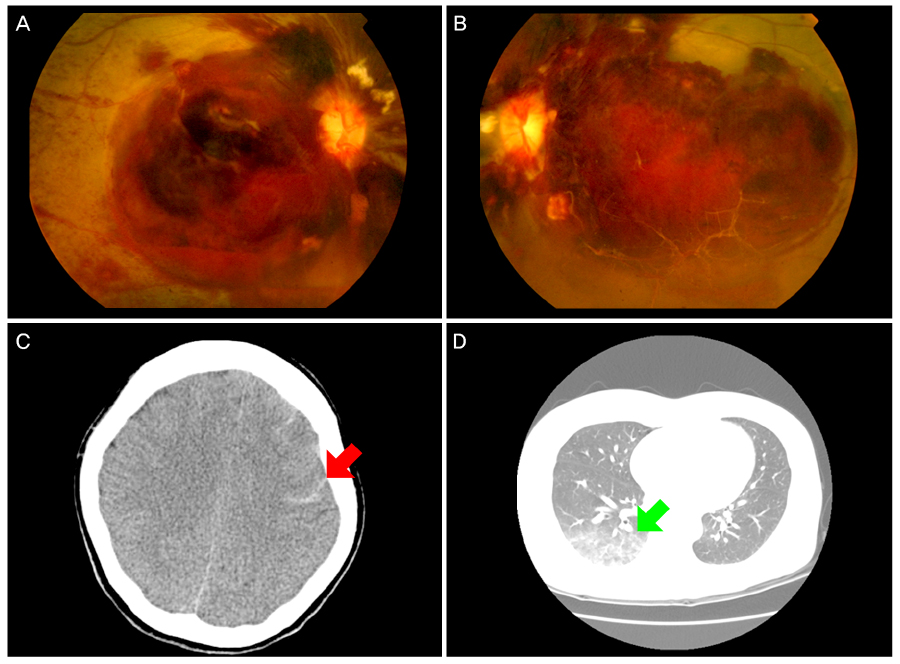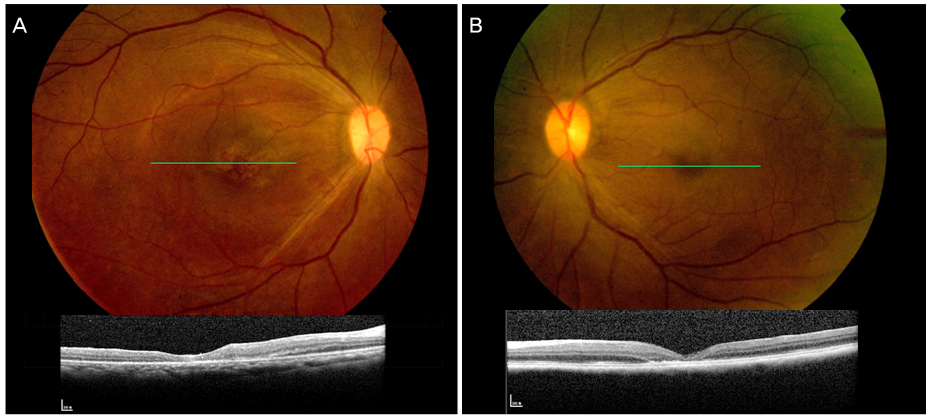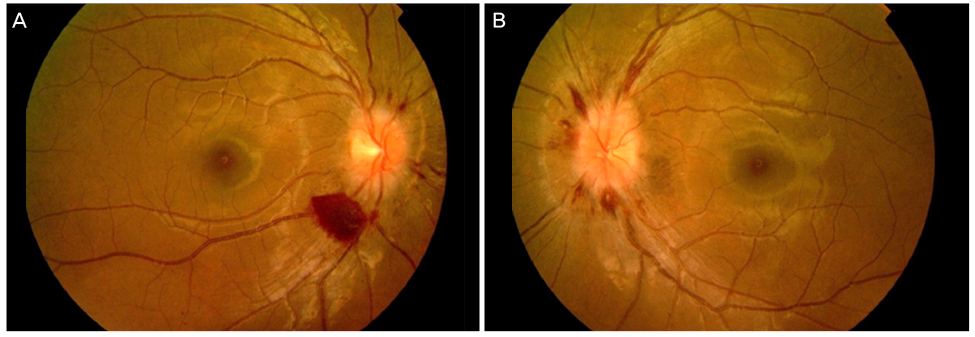J Korean Ophthalmol Soc.
2017 Jun;58(6):745-750. 10.3341/jkos.2017.58.6.745.
Retinoic Acid Syndrome and Pseudotumor Cerebri in Patients with Acute Promyelocytic Leukemia
- Affiliations
-
- 1Department of Ophthalmology, Kyungpook National University School of Medicine, Daegu, Korea. jps11@hanmail.net
- KMID: 2382687
- DOI: http://doi.org/10.3341/jkos.2017.58.6.745
Abstract
- PURPOSE
To report cases of a retinal, preretinal and vitreous hemorrhage due to retinoic acid syndrome and a papilledema caused by increased intracranial pressure in patients with acute promyelocytic leukemia treated with all-trans retinoic acid (ATRA).
CASE SUMMARY
(Case 1) A 48-year-old female visited our clinic with headache, dyspnea, and visual disturbance during ATRA medications for acute promyelocytic leukemia. Her visual acuity of both eyes was hand motion, and fundus examination revealed extensive retinal, preretinal, and vitreous hemorrhage. The laboratory test showed leukocytosis and computed tomography of brain and chest revealed subarachnoid hemorrhage and pulmonary alveolar hemorrhage. She was diagnosed with retinoic acid syndrome and was treated with vitrectomy in both eyes. (Case 2) A 17-year-old male, who had been treated with ATRA for acute promyelocytic leukemia, had headache and visual disturbance. His best-corrected visual acuity was 1.0 in both eyes, but the fundus examination showed papilledema and retinal hemorrhage in both eyes. Goldmann visual field examination revealed an enlarged blind spot in both eyes. He was diagnosed with papilledema caused by ATRA induced increased intracranial pressure, and was observed.
CONCLUSIONS
Patients with acute promyelocytic leukemia treated with ATRA may have retinoic acid syndrome and increased intracranial pressure that could result in retinal hemorrhage, vitreous hemorrhage, and papilledema.
Keyword
MeSH Terms
-
Adolescent
Brain
Dyspnea
Female
Hand
Headache
Hemorrhage
Humans
Intracranial Pressure
Leukemia, Promyelocytic, Acute*
Leukocytosis
Male
Middle Aged
Optic Disk
Papilledema
Pseudotumor Cerebri*
Retinal Hemorrhage
Retinaldehyde
Subarachnoid Hemorrhage
Thorax
Tretinoin*
Visual Acuity
Visual Fields
Vitrectomy
Vitreous Hemorrhage
Retinaldehyde
Tretinoin
Figure
Reference
-
1. Tallman MS, Kwaan HC. Reassessing the hemostatic disorder associated with acute promyelocytic leukemia. Blood. 1992; 79:543–553.2. Bennett JM, Catovsky D, Daniel MT, et al. French-American-British (FAB) co-operative group. Proposals for the classification of the acute leukaemias. Br J Haematol. 1976; 33:451–458.3. Larson RA, Kondo K, Vardiman JW, et al. Evidence for a 15;17 translocation in every patient with acute promyelocytic leukemia. Am J Med. 1984; 76:827–841.4. Koeffler HP. Induction of differentiation of human acute myelogenous leukemia cells: therapeutic implications. Blood. 1983; 62:709–721.5. Huang ME, Ye YC, Chen SR, et al. Use of all-trans retinoic acid in the treatment of acute promyelocytic leukemia. Blood. 1988; 72:567–572.6. Fenaux P, Chastang C, Chomienne C, Degos L. European APL Group. Tretinoin with chemotherapy in newly diagnosed acute promyelocytic leukaemia. Lancet. 1994; 343:1033.7. Frankel SR, Eardley A, Heller G, et al. All-trans retinoic acid for acute promyelocytic leukemia. Results of the New York Study. Ann Intern Med. 1994; 120:278–286.8. Frankel SR, Eardley A, Lauwers G, et al. The “retinoic acid syndrome” in acute promyelocytic leukemia. Ann Intern Med. 1992; 117:292–296.9. Roytman M, Frumkin A, Bohn TG. Pseudotumor cerebri caused by isotretinoin. Cutis. 1988; 42:399–400.10. Mahmoud HH, Hurwitz CA, Roberts WM, et al. Tretinoin toxicity in children with acute promyelocytic leukaemia. Lancet. 1993; 342:1394–1395.11. Yeh YC, Tang HF, Fang IM. Pseudotumor cerebri caused by all-trans-retinoic acid treatment for acute promyelocytic leukemia. Jpn J Ophthalmol. 2006; 50:295–296.12. De Botton S, Dombret H, Sanz M, et al. The European APL Group. Incidence, clinical features, and outcome of all trans-retinoic acid syndrome in 413 cases of newly diagnosed acute promyelocytic leukemia. Blood. 1998; 92:2712–2718.13. Warrell RP Jr, de Thé H, Wang ZY, Degos L. Acute promyelocytic leukemia. N Engl J Med. 1993; 329:177–189.14. Visani G, Bontempo G, Manfroi S, et al. All-trans-retinoic acid and pseudotumor cerebri in a young adult with acute promyelocytic leukemia: a possible disease association. Haematologica. 1996; 81:152–154.15. Spector RH, Carlisle J. Pseudotumor cerebri caused by a synthetic vitamin A preparation. Neurology. 1984; 34:1509–1511.16. Holmes D, Vishnu P, Dorer RK, Aboulafia DM. All-trans retinoic acid-induced pseudotumor cerebri during induction therapy for acute promyelocytic leukemia: a case report and literature review. Case Rep Oncol Med. 2012; 2012:313057.
- Full Text Links
- Actions
-
Cited
- CITED
-
- Close
- Share
- Similar articles
-
- Sweet Syndrome Developed in a Patient of Acute Promyelocytic Leukemia During Remission Induction Therapy with All-trans Retinoic Acid
- All-trans Retinoic Acid induced Myositis in a Patient with Acute Promyelocytic Leukemia
- Reversible Symptomatic Myocarditis Induced by All-Trans Retinoic Acid Administration during Induction Treatment of Acute Promyelocytic Leukemia: Rare Cardiac Manifestation as a Retinoic Acid Syndrome
- All-trans Retinoic Acid-induced Nephrotic-range Proteinuria in a Patient with Acute Promyelocytic Leukemia
- Differentiation Syndrome with Ocular Manifestations in Acute Promyelocytic Leukemia Patients Treated with All-trans Retinoic Acid





